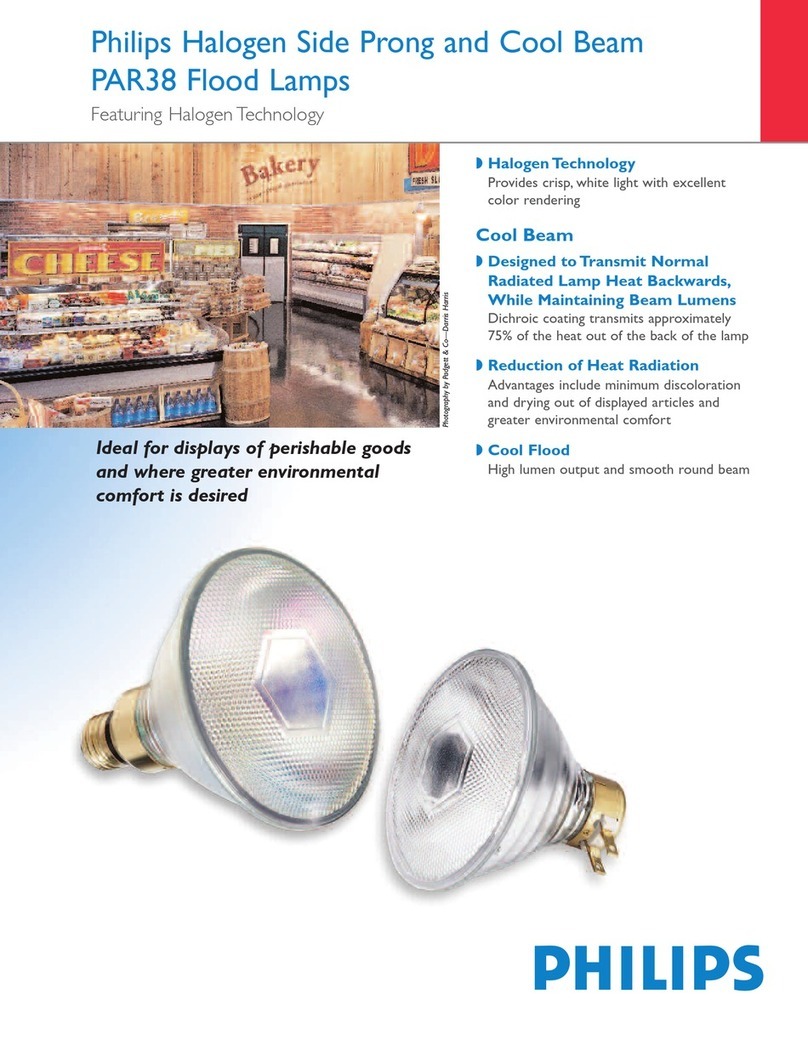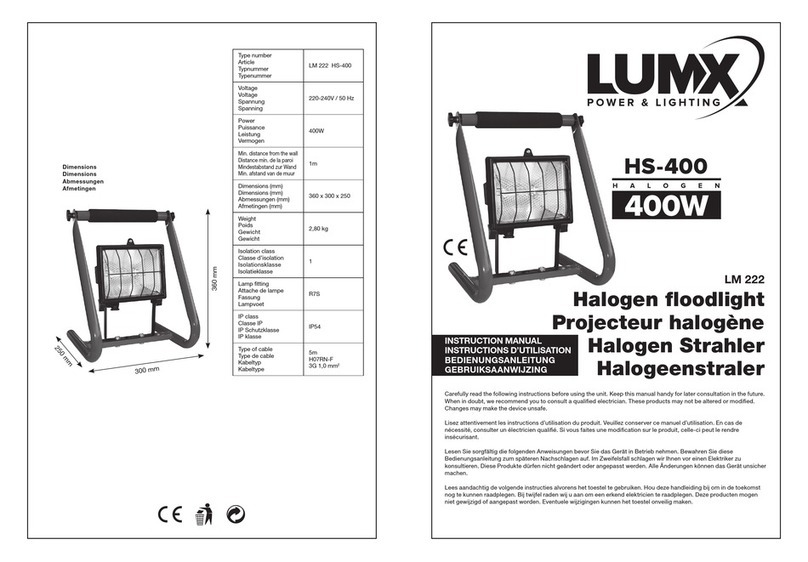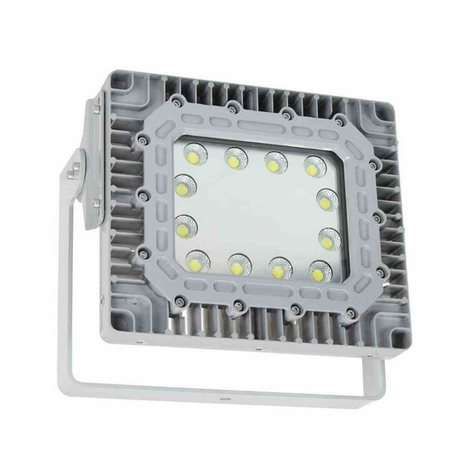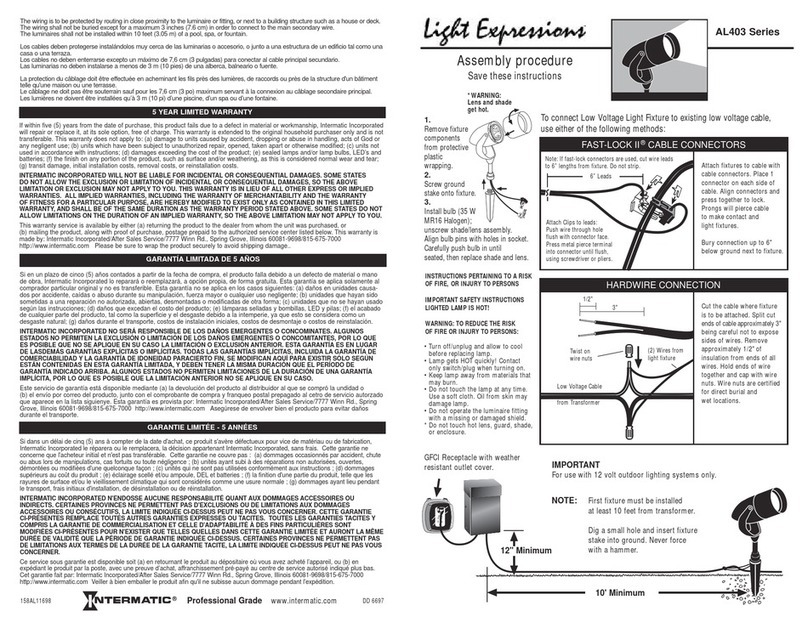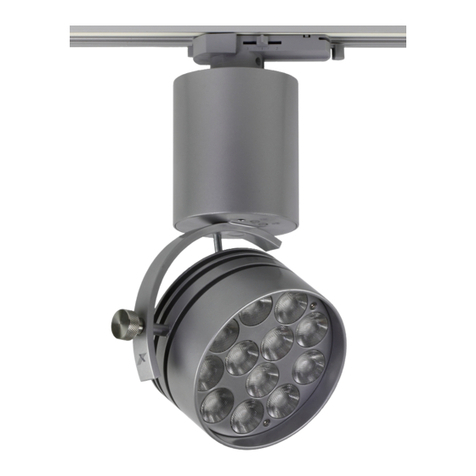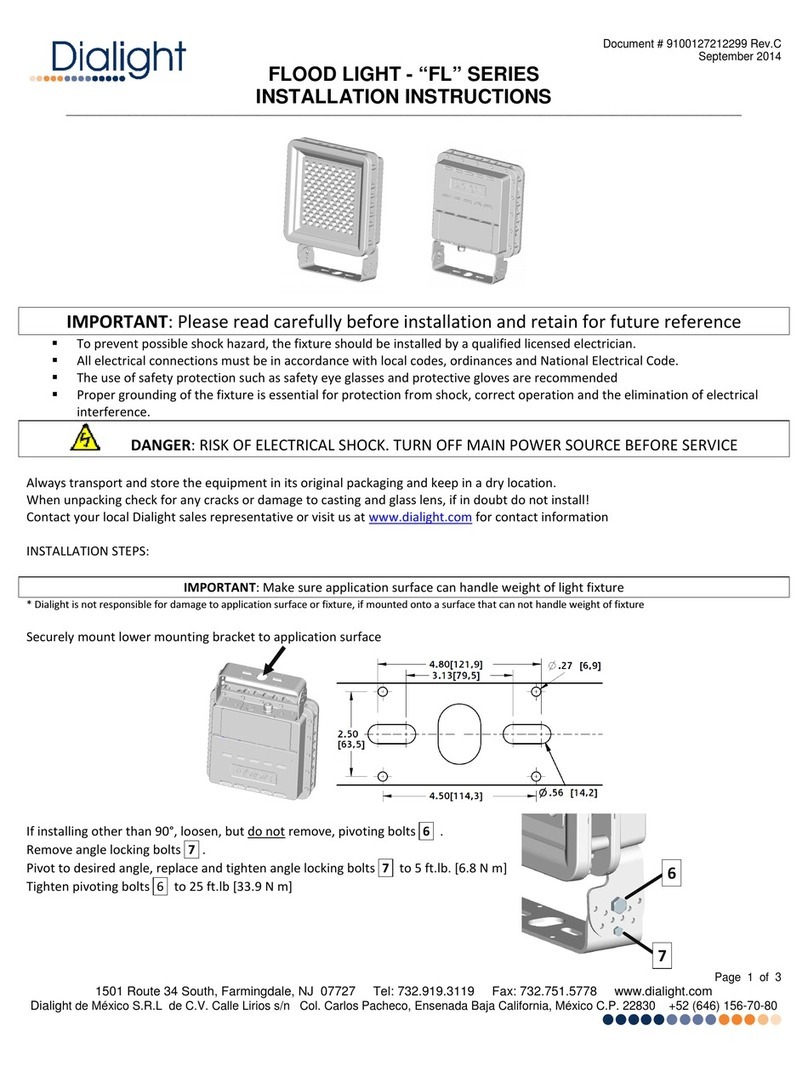Feltest PowerStrobe User manual

1
Manual
PowerStrobe
Release Date 01/2011

2
READ BEFORE OPERATING UNIT !
Operation
The POWERSTROBE operates at LETHAL High Voltages inside the lamp and electronic
compartments. Disconnect unit from power supply before replacing lamp.
Viewing of this light by people with photosensitive epilepsy may trigger epileptic
seizures.
Eye damage may result from direct viewing of the ultraviolet lamp used in this unit.
Do Not Operate a PowerStrobe in Explosive Areas
CAUTION: Lens may be extremely HOT after operation, allow to cool as necessary.
Servicing
Servicing this equipment beyond changing the flashlamp and Air Filters is not
recommended.
For repair, consult: Feltest Equipment BV
Hoofdweg 131 unit-D
7371GG Loenen
(+31) 313 652 215
The information in this manual was current when published.
The manufacturer reserves the right to revise and improve its product.
All specifications are therefore subject to change without notice.

3
TABLE OF CONTENTS
1
WARNING
I.
4
WELCOME TO THE POWERSTROBE
II.
5
INTRODUCTION
External & Internal Trigger Mode
Three Intensity Levels
Three Flash Rate Ranges
Built-in Memory Feature
III.
8
OPERATION
Internal Mode
External Mode
PowerStrobe Control Panel
Intensity & Flash Rate Range Control
Auto Scale Flash Rate Range
IV.
11
(EXTERNAL) INTERFACE
Trigger Input Connector Pin Assignments
V.
12
SPECIFICATIONS
Photometry Diagram
VI.
15
DC POWER PACK RUN TIME
VII
16
IMPORTANT SAFETY NOTES DC POWER PACK
VIII
17
CHARGING THE DC POWER PACK
IX.
21
CHANGING THE LAMP
X
23
CHANGING THE FILTERS
XI
26
SPARE PARTS & ACCESSORIES
XII
29
SERVICE & WARRANTY

4
I. WELCOME TO THE POWERSTROBE
FEATURES
Self-contained portable design - no separate high voltage power supply
Operates from a rechargeable 14V DC Power Pack or A/C connector
Provides three Intensity Levels in low flash ranges
Long lamp life
Accepts remote synchronization (trigger) signals
Variable 0- 360 degree External Trigger Delay
Measures True RPM
Rugged Lamp mounting assembly
A large, bright easy to read LED display
Built in low battery indicator
Superior design reflector offers uniform area illumination
1 hour charger
STOPPING THE BLUR
When objects move at high speed, the human eye cannot focus on a single
image. As a result, the eye can only see "blur". But strobe lighting stops the
blur. By flashing with high intensity for extremely short durations, a strobe
light will "freeze" objects traveling at speeds that cause blur. [See
Illustrations Below]
During these short flashes, an object moving at 600 meters per minute
moves only 0.2mm a n d it appears to be stationary since the eye captures
and retains only brief visual images. This result makes detailed inspection
possible.
TRUE COLORS
Feltest PowerStrobes emit an excellent white light approaching sunlight that
reveals true colors. The light's scientific color temperature is 6500 Kelvin.

5
II. I N T RO D U C T I O N
The PowerStrobe provides narrow beam spot illumination of a flat surface covering
50cm to 100cm. This illuminated area results when using the PowerStrobe at its
intended 5 cm to 5m distance.
Larger areas can be illuminated by using PowerStrobe at greater distances, however,
this will result in a corresponding reduction of light at the surface being inspected.
HOW TO SET THE FLASH RATE
Flash rate should be adjusted within these limits for non-synchronous
inspection. Non-synchronous inspection is defined as looking for flaws or
random events on non- printed webs moving at production speeds.
(Note: In pattern inspection, flash rate must be set to synchronize).
FOR SURFACE QUALITY ON STEEL / PAPER / FILM
Adjust flash rate to exceed 50 Flashes per Second (F/S) (3000 per
minute). Rates below 50 F/S can be dangerous and disruptive to
personnel affected in the immediate area (See Warning on first
page). Therefore, 50 F/S should be your minimum flash rate.
Flash rates should not allow more than 15cm to 30cm of material
to pass between flashes. Therefore, to calculate the maximum
rate, divide the line speed in centimeters per second by 30, and
this will be the maximum flash frequency in Flashes per Second.
Experience gained from many industries using non-synchronous inspection
lighting shows that flash rates between 60-80 F/S (3600 –4800 Flashes per
Minute, F/M) work best depending on speed of the material.
For synchronous inspection of printed webs or rotating parts, set
the PowerStrobe flash rate to the highest setting. While viewing the
action lit by PowerStrobe, gradually lower the flash rate. When the
first single image appears, the light is synchronized to the exact
repeat speed of the web or rotating part. The display will indicate
the speed in repetitions per minute or second.
For paper formation / activity studies, Flash Rates between
25-35 F/S work best depending on speed and type of paper made.

6
External and
Internal
Trigger
Mode
The flash rate of the PowerStrobe can be controlled by an external trigger
signal, or the flash rate Up & Down control keys.
External mode
When the external trigger connector is installed, the internal rate control is
disabled and the PowerStrobe will flash synchronously with each external
trigger signal.
The PowerStrobe provides two external trigger input channels which are fac-
tory set for accepting the following signal types.
V - C
Option:
Video & Contact Closure
•Video: 1v p-p unterminated, triggers on 50Hz or 60Hz vertical sync.
•Contact: Contact closure or open collector, > 8VDC @ 10mA rating
V - P
Option:
Video & Pulse
•Video: 1v p-p unterminated, triggers on 50Hz or 60Hz vertical sync.
•Pulse: +2.5V pk minimum, > 100µsec pulse width.
Internal mode
In internal mode the flash rate is set by using the Up & Down rate control
keys over the range of 30 Flashes per Minutes (F/M) to 18000 F/M.
Pressing and releasing the Up & Down keys changes the flash rate in
single steps. By pressing and holding the Up & Down keys for longer
than 1 second, the flash rate is scanned at an approximate speed equal to
10F/S per second.

7
Three
Intensity Levels
The PowerStrobe provides three intensity levels for tailoring the flashlamp
brightness to the actual inspection application.
The flashlamp intensity is set by using the intensity control key to
select 100%, 66%, and 33% levels, depending on the operating flash rate.
The selected intensity level also selects the flash rate range and auto-
matically limits the maximum flash rate.
Three Flash Rate
Ranges
Maximum flash rates of 6000 F/M, 12000 F/M, and 18000 F/M are
provided and are automatically set by the selected intensity level as fol-
lows:
Intensity
Level Flash Rate
Range
100% 30 F/M to 6000 F/M
66% 30 F/M to 12000 F/M
33% 30 F/M to 18000 F/M
Built-In
Memory
Feature
The PowerStrobe contains a built-in memory feature that automatically
updates and stores its last used control setup, each time the push but- ton
on/off trigger switch is released.
Control parameters are automatically stored as long as they remain unchanged
for a 5 second period before releasing the on/off trigger switch.

8
I I I . O P E R A T I O N
The PowerStrobe co nt a i ns a mo me nt ar y push b ut t o n s w i t c hi n its t ri g ge r
handle asse mbl y. When t his sw itch is hel d i n its onp os it io n, the
PowerStrobe can b e o pe ra te d i n In te rn al or E xte rn a l tri gg er mod e.
1. Int ern al Mode:
In thi s mo de , the rate o f st rob e fla sh in gis set by the f la s h ra te up &
do wn key s on the PowerStrobe c o n tr o l pa n e l.
2. E xte r nal M o de:
The e xt e rn a l mo d e o f o p e ra t i o n i s a u to m at ic a l l y s el ec t e d w h e ne v e r
the pre wire d tri gge r sign al ca b le is pl u g ge d i nto the PowerStrobe tr ig ge r
c o nn e c to r. ( S ee in t e rf a c e s e ct i o n ) .
Po w erS tr o be
Co nt rol
P a n e l
Flash Rate UP & DOWN Keys: •Press key to change flash rate
•Hold key to scan flash rate
The scan rate is ± 10 F/S per second.
Mode Key: •Press key to change units of flash rate display from
Flashes/Sec to Flashes/Min
•Degree units can also be selected when using external
trigger signals and phase delay mode

9
Intensity
Key: • Press key to set flashlamp intensity to
100%, 66%, or 33% level
The maximum flash rate is automatically limited by the selected
intensity level as follow:
100% intensity = 100F/S Max - 6000 F/M
66% Intensity = 200 F/S Max - 12000 F/M
33% Intensity = 300 F/S Max - 18000 F/M
•Indicates selection of Flashes/Sec units for flash rate display.
•Indicates selection of Flashes/Min units for flash rate display.
•Indicates Phase Delay setting when operating from external trigger signals
.
•Phase Delay mode can only be selected when an external trigger cable
is connected to the PowerStrobe trigger input connector.
•When operating in Phase Delay mode, the flash rate display shows the
phase delay from 0° to 360° set by the Up & Down rate keys.
•Five Digit Display for indicating the flash rate set by the Up & Down rate
keys, or phase delay when selected.
•Intensity indicator for displaying selected intensity level (100%,66% 33%)
•External Trigger indicator
- illuminates when an external trigger cable is connected.
- blinks when the external trigger rate exceeds the max flash rate for the
selected intensity range.
•Fan Fault indicator
- illuminates if the internal cooling fan fails to operate.
A fan fault condition automatically shuts down the PowerStrobe flash lamp circuit.
•Low Battery indicator - blinks when the DC Power Pack requires recharging.

10
Intensity & Flash Rate Range Control
The PowerStrobe provides three flash rate ranges that are automatically
set by the selected intensity level.
The relationship between selected intensity levels and their corresponding
flash energy and maximum flash rate is presented below.
NOTE: F/S = Flashes/Second and F/M = Flashes/Minute
100%
Intensity:
•Flash Energy = 0.85 joules/flash
•Max Flash Rate = 100 F/S, 6000 F/M
66%
Intensity:
•Flash Energy = 0.43 joules/flash
•Max Flash Rate = 200 F/S, 12000 F/M
33%
Intensity:
•Flash Energy = 0.28 joules/flash
•Max Flash Rate = 300 F/S, 18000 F/M
Auto-Scale Flash Rate Range Feature
The PowerStrobe has a built-in flash rate divider/multiplier feature for maintaining
synchronous flash rates throughout the three intensity level selections.
This feature is automatically activated whenever the operating flash rate exceeds the
max rate for the selected intensity level.
The following example illustrates this feature:
Initial Conditions: Intensity = 33% at Flash Rate = 300 F/S
•Operator changes intensity to 66% -> Auto scale feature sets flash rate to 150 F/S
•Operator changes intensity to 100% -> Auto scale feature sets flash rate to 75 F/S
•Operator changes intensity to 33% -> Auto scale feature sets flash rate back to 300 F/S

11
I V . E X T E R N AL I N T E R F AC E
The trigger input connector is located on the unders ide of the PowerStrobe.
Trigger Input
Connector
Pin
Assignments
The trigger connector i s a six pin circularDin type.
The connector pin assignments & descriptions are as follows.
•Pin 1 : Open collector trigger output for synchronizing a second unit
•Pin 2 : Video signal trigger input
•Pin 3 : Contact Closure or Pulse Trigger input,
depending on the customer option ordered
•Pin 4 : External Mode control line for selecting external trigger mode
(See Note below)
•Pin 5 : Trigger Supply +14V DC output, connected to a DC Power Pack
•PIN 6 :Ground reference for all trigger signals and trigger DC supply
Note:
The trigger connector mating plug used on the PowerStrobe external trigger
cables supplied by Feltest contains an internal jumper from Pin 4 to Pin 6.
This internal connection automatically selects external mode of operation

12
V . S P E C I F I C A T I O N S
DC Power
Pack:
•Rechargeable NiCd cells
•14.4 VDC nominal voltage
•2.4 Amp hour
•DC Power Pack Run Time-See pg.20
Triggering
Internal
•30 Flashes / Min (F/M) to 18000 F/M
•Automatically limits to max rate of selected intensity
level (6000 F/M, 12000 F/M, 18000 F/M)
•1 F/M resolution
•100 ppm/°C accuracy
External •Video 1vp-p unterminated, triggers from 50Hz-60Hz
vertical sync
•Pulse Source: > +2.5v pk, 100µsec min pulse width
Input impedance 10kž
•Contact Closure: > 8 VDC @ 10mA rating
•0-360 Degree phase delay adjustment available when
using external triggering.
•Phase delay accuracy ± 1 degree
Trigger Sensor Supply: +14.4 VDC nominal, internally connected to a
DC Power pack
Trigger to Flash Delay: 5µsec
Time Base Accuracy: .01%
Temperature Stability: ±.01% per °C
Update Time: 100msec

13
Energy Output : Energy per flash is set by selected intensity level as follows:.
100% Intensity : 0.85 joules / flash
66% Intensity: 0.43 joules / flash
33% Intensity : 0.28 joules / flash
Light Output: 1800 Lux at 4.6 meter 100% intensity, 6000 F/M
Flash Duration: 20 microseconds
Power into Flash Lamp: 85 watts max
Physical: •Dimensions: 168.3mm X 161.9mm X 336.5mm
•Weight (with DC power pack) 2.34 kg
Environmental: •Continuous operating temperature range:
0°C to 40°C (32°F to 104°F)
•Humidity: 95% noncondensing.

14
PHOTOMETRY
The isolux chart below shows the PowerStrobe illumination pattern at a target distance
Inches
CentimetersLux
24 in
60 cm
200
18 in
45 cm
300
12 in
30 cm
500
6 in
15 cm
1000
2 in
5 cm
1800
NOTES:
- The distance increments shown above represent displacement from target center
- Flash rate set to 6000 f/m [flashes per minute]

15
V I . D C P o w e r P a c k R u n T i m e
The PowerStrobe u ni t di sp l a y co nt ain s a low b a tt e r y i n di c a t o r
t ha t bl i nk s wh e ne v e r the D C P o w e r Pack ne ed s r e c ha rging.
The DC Power Pack run time is re late d to the op e rat ing f las h rat eand
s el ec t e d i n t en s i t y l e v e l (i. e. pow er dem a nd ).
The tab le bel ow i ll us tr ate s a few e xa mp le s o f the D C P o we r
Pack run time as a fun c tio n of op era t in g fla sh rat e & i nt ens it y.
Op er ati n g C on di tio n s DC Pow er Pack Run Time
•Fl ash Rat e = 3600 F/M 80 mi n ute s
•I nt e n s it y = 33%
•Fl ash Rat e = 3600 F/M 30 mi n ute s
•I nt e n s it y = 100%
•Fl ash Rat e = 6000 F/M 20 mi n ute s
•I nt e n s it y = 100%
The PowerStrobe cha rger will c ha rge the DC Power Pack in a pp r o xi m a t el y
1 ho ur.
To c ha rge the PowerStrobe DC Power Pack, fol l ow the i ns t ru c t io n s.

16
V I I . I M P OR T A N T S A F E T Y I N ST R U C T I ON S f o r P O W E R P A C K
WARNING:
When using electrically operated equipment, basic safety precautions
should always be followed to reduce risk of fire and personal injury.
•Do not incinerate the DC Power Pack even if it is severely damaged
or is completely worn out. The DC Power Pack can explode in a fire.
•A small leakage of liquid from the DC Power Pack cells may occur under
extreme usage or temperature conditions. This does not indicate a failure.
However, if this leakage gets on your skin:
a. Wash quickly with soap and water.
b. Neutralize with a mild acid such as lemon juice or vinegar
c. If the DC Power Pack liquid gets into your eyes, flush them with clean water
for a minimum of 10 minutes and seek immediate medical attention.
(MEDICAL NOTE: The liquid is 25%-35% solution of potassium hydroxide.)
•Never attempt to open the DC Power Pack for any reason.
If the plastic housing of the DC Power Pack breaks or cracks,
immediately discontinue use and do not recharge.
DC PACK CELLS
After several years of normal use, the cells in your DC Power Pack will no
longer accept a charge. This is a normal occurrence, and signifies that the DC Power
Pack cells have reached the end of their useful life. Replacement DC Power
Packs are available from Feltest, order part No. UPN 77-1055.
Your DC Power Pack contains nickel cadmium cells. The Environmental Protection
Agency considers cadmium to be a toxic material that can do severe damage to the
environment. Check with your state Environmental Protection Agency to find out
how to properly recycle or dispose of your DC Power Pack.

17
VIII. CHARGING THE DC POWER PACK
To minimize the possibility of reduced DC Pack capacity due to cell memory
effect, do not charge the DC Power Pack until the low battery indicator is
illuminated !
To Charge the DC Power Pack
1. Press the release buttons on the DC Power Pack and firmly pull the Pack out of the
PowerStrobe DC Power handle.
2. Connect charger to an appropriate outlet before inserting DC Power Pack.
3. Insert the DC Power Pack into the charger as shown above.
The red light will blink continuously indicating that the charging process has started.
•Charge time is approximately 1 hour.
4. The completion of charge will be indicated by the red light remaining ON continuously.
5. The pack is fully charged and may be used at this time or left in the charger.
CAUTION:
MAINS voltage present at charging terminals. Do not probe with conductive objects.
Danger of electric shock or electrocution may result.

18
CHARGER
INDICA
TOR
HOT/COLD PACK DELAY
When the charger detects a DC Power Pack that is hot or cold, it automatically starts a
Hot/Cold Pack Delay, suspending charging until the pack temperature has stabilized.
After the DC Power Pack cooled, the charger automatically switches to the Pack
Charging mode. This feature ensures maximum battery life. The red light flashes
long, then short while in Hot/Cold Delay mode.
REPLACE PACK
The charger is designed to detect certain problems that can arise with DC Power Packs
which would be indicated by the red light flashing at a fast rate.
If this occurs, reinsert DC Power Pack. If problem persists, try a different pack to
determine if charger is OK. If the new pack charges correctly, then the original pack is
defective and should be returned to Feltest for recycling. If the
new DC Power Pack elicits the same trouble indication as the original, have charger
tested by an authorized Feltest service center.
PROBLEM POWER LINE
If the input voltage is out of tolerance, the charger may temporarily suspend
operation and begin flashing the red light (two fast blinks followed by a pause). This
indicates the power source is out of limits. If the voltage returns to an acceptable
level, the charger will automatically switch to a normal charging mode and flash
accordingly.
LEAVING THE DC POWER PACK IN THE CHARGER
The charger and DC Power Pack can be left connected with the red light glow- ing
indefinitely. The charger will keep the DC Power Pack fresh and fully charged.

19
IMPORTANT CHARGING NOTES
1. Longest life and best performance can be obtained if the DC Power Pack is charged
when the air temperature is between 65°F and 75°F (18°C - 24°C).
To prevent from damage DO NOT charge the DC Power Pack in an air temperature
below +40°F (+4°C), or above +105°F (+40°C).
2. The charger and DC Power Pack may become warm to touch while charging.
This is a normal condition, and does not indicate a problem.
3. If the DC Power Pack does not charge properly, (1) Check power at receptacle by
plugging in another piece of equipment, (2) Move charger and pack to a location
where the surrounding air temperature is approximately 65°F - 75°F (18°C - 24°C), (3) If
charging problems persist, take or send the equipment, DC Power Pack and charger to
an authorized Feltest service center.
4. The DC Power Pack should be recharged when it fails to produce sufficient power
enough to keep the equipment functioning properly.
DO NOT CONTINUE to use under these conditions.
Follow the charging procedure. You may also charge a partially used pack whenever
you desire with no adverse effect on the DC Power Pack.
5. Under certain conditions, with the charger plugged in to the power supply, the
exposed charging contacts inside the charger can be shorted by foreign material.
Foreign materials of a conductive nature such as, steel wool, aluminum foil, or any
buildup of metallic particles should be kept away from charger cavities. Always unplug
the charger from the power supply when there is no DC Power Pack in the cavity.
Unplug the charger before attempting to clean.
6. Do not immerse charger in water or any other liquid.
7. For optimum performance, leave the DC Power Pack in the charger for six hours or
more once every 10 to 20 recharges. This balances the cells, keeps the pack at peak
performance and extends the usable life of the pack.
WARNING: Do not allow any liquid to get inside charger. Electric shock may result. To
facilitate the cooling of the DC Power Pack after use, avoid placing the charger or pack
in a warm environment.
CAUTION: Never attempt to open the DC Power pack for any reason. If the plastic
housing of the pack breaks or cracks, return the DC Power Pack to Feltest.

20
IMPORTANT SAFETY INSTRUCTIONS for 14.4V 1 HOUR
CHARGER
·
This manual contains important safety and operating instructions for the
Feltest DC Power Pack 1 Hour Charger
·
Before using the charger, read all instructions and cautionary markings on
charger, (2) DC Power Pack, and (3) product using DC Power Pack.
·
DANGER: LINE VOLTAGE PRESENT AT CHARGING TERMINALS. Do not probe
with conductive objects. Danger of electric shock or electrocution.
·
DANGER: If the DC Power Pack case is cracked or damaged, do not insert into
charger. Danger of electric shock or electrocution.
·
DANGER: Never attempt to open the DC Power Pack for any reason. If the
plastic housing of the DC Power Pack breaks or cracks, return to Feltest for
recycling.
·
DANGER: Don't allow any liquid to get inside charger. Electric shock may
result. To facilitate the cooling of the DC Power Pack after use, avoid placing
the charger or DC Power Pack in a warm environment such as in a metal shed,
or an uninsulated trailer.
·
CAUTION: To reduce risk of injury, charge only Feltest rechargeable DC Power
Packs. Other types of Power packs may burst, causing personal injury and
damage.
·
Do not expose charger to rain or snow.
·
Use of an attachment not recommended or sold by Feltest may result in a risk
of fire, electric shock, or injury to persons.
·
These chargers are not intended for any uses other than charging Feltest
rechargeable DC Power Packs. Any other uses may result in a risk of fire,
electric shock, or electrocution.
·
To reduce risk of damage to electric plug and cord, pull by plug rather than
cord when disconnecting charger.
·
Make sure cord is located so that it will not be stepped on, tripped over, or
otherwise subjected to damage or stress.
·
An extension cord should not be used unless absolutely necessary. Use of
improper extension cord could result in risk of fire, electric shock, or
electrocution.
Table of contents

